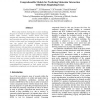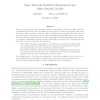1826 search results - page 29 / 366 » Using Random Forests in the Structured Language Model |
ICMLA
2008
13 years 10 months ago
2008
When using machine learning for in silico modeling, the goal is normally to obtain highly accurate predictive models. Often, however, models should also bring insights into intere...
ECCC
2007
13 years 8 months ago
2007
We prove space hierarchy and separation results for randomized and other semantic models of computation with advice where a machine is only required to behave appropriately when g...
CIKM
2008
Springer
13 years 10 months ago
2008
Springer
The two most important tasks in information extraction from the Web are webpage structure understanding and natural language sentences processing. However, little work has been don...
SCM
1998
13 years 10 months ago
1998
As part of an investigation of scalable development techniques for systems written in the JavaTM programming language, the Forest Project is building JP, a prototype distributed pr...
ICDCS
1995
IEEE
14 years 5 days ago
1995
IEEE
This paper presents a token-based K-mutual exchsion algorithm. The algorithm uses K tokens and a dynamic forest structure for each token. This structure is used to forward token r...


